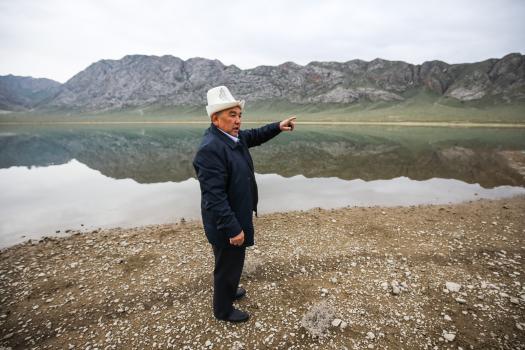Three Ways USAID Brought Water Security and Sanitation into the Climate Conversation at COP26
At the 26th Conference of the Parties (COP26) in November 2021, leaders from nearly 200 countries came together to establish ambitious plans of action to adapt to and mitigate the threat of climate change and decrease levels of global greenhouse gas emissions in the atmosphere. The Water Pavilion, the first at any COP, elevated water security within the broader climate agenda. The Pavilion was a collaboration among 30 organizations, governments, and companies dedicated to water action as an essential part of building climate resilience and sustainable development.
Like weights on a scale, water can tip our future in one direction or the other: water can make communities flourish or leave them unlivable. The U.S. Agency for International Development (USAID) brought water security and sanitation into the conversation at COP26 in the following three ways:
- Leveraging finance for climate-resilient water and sanitation services. Water and sanitation are vital parts of the President’s Emergency Plan for Adaptation and Resilience (PREPARE), which President Biden announced at COP26. As part of PREPARE, USAID announced it will mobilize $1 billion of public and private finance for climate-resilient water and sanitation services by 2030. USAID plans to partner with national and sub-national governments, water and sanitation service providers, NGOs, and development and commercial financial institutions to help meet the ambitious target.
- Embracing nature-based solutions. In the Water Pavilion session, “Water-wise Nature-Based Solutions to Turn Climate Risks Into Opportunities for Action” on November 4, USAID Deputy Assistant Administrator & Climate Change Coordinator Gillian Caldwell emphasized that USAID supports nature-based solutions as a cost-effective way to enhance water security. “Conservation and reforestation can regulate water quality by filtering runoff and preventing erosion. Mangroves, wetlands, and dunes reduce the impact of floods,” Caldwell said. “When nature-based solutions like these work in tandem with other basic infrastructure, they help to reverse [alarming water security trends]—and they also increase community resilience to climate change.” Listen to Caldwell speak here.
- Funding local ownership of solutions. In the closing session of the Water Pavilion on November 12 on “Fragile Flows: Tackling Climate Security and Adaptation Challenges through Water Systems,” I described the most critical WASH and climate security issues to address now and at the next COP. I emphasized that local partners need to be at the forefront of water and climate security solutions for outcomes to be durable: “Current estimates project that less than 10 percent of climate finance reaches local levels and at-risk groups including women and Indigenous Peoples. Expanding access to funding for creative ideas from new and underrepresented partners and investing in local capacity development ensures sustainable development outcomes and upholds values of transparency and accountability.” Watch my session here.
Investing in climate-resilient infrastructure and services can help water supply and sanitation services withstand climate change impacts and ensure continuity of services to vulnerable populations, which mitigates economic losses and health impacts from climate-related extreme events. WASH and water resource management are key parts of the draft USAID 2022-2030 Climate Strategy. In 2022, USAID will partner with the Department of State and others to deliver the next U.S. Government Global Water Strategy, which will outline ways to create a climate-resilient, water-secure world.
To learn more about USAID’s efforts, visit the Global Waters Water Security, Sanitation, and Climate Change page.
Maura Barry is the Senior Deputy Assistant Administrator in USAID’s Bureau for Resilience and Food Security and interim Global Water Coordinator


